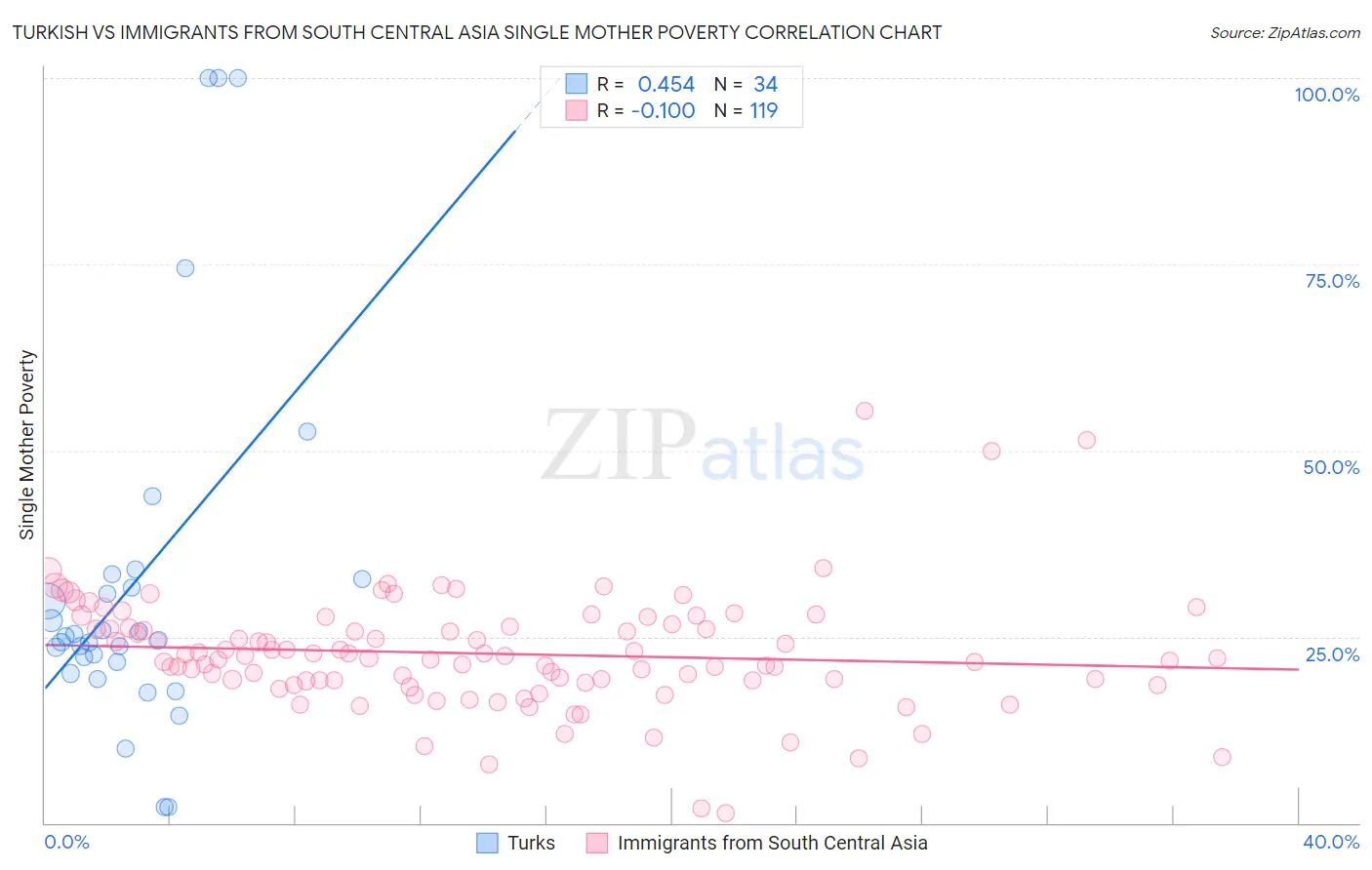Turkish vs Immigrants from South Central Asia Single Mother Poverty
COMPARE
Turkish
Immigrants from South Central Asia
Single Mother Poverty
Single Mother Poverty Comparison
Turks
Immigrants from South Central Asia
26.4%
SINGLE MOTHER POVERTY
100.0/ 100
METRIC RATING
30th/ 347
METRIC RANK
25.3%
SINGLE MOTHER POVERTY
100.0/ 100
METRIC RATING
10th/ 347
METRIC RANK
Turkish vs Immigrants from South Central Asia Single Mother Poverty Correlation Chart
The statistical analysis conducted on geographies consisting of 265,895,030 people shows a moderate positive correlation between the proportion of Turks and poverty level among single mothers in the United States with a correlation coefficient (R) of 0.454 and weighted average of 26.4%. Similarly, the statistical analysis conducted on geographies consisting of 457,659,599 people shows a slight negative correlation between the proportion of Immigrants from South Central Asia and poverty level among single mothers in the United States with a correlation coefficient (R) of -0.100 and weighted average of 25.3%, a difference of 4.7%.

Single Mother Poverty Correlation Summary
| Measurement | Turkish | Immigrants from South Central Asia |
| Minimum | 2.2% | 1.4% |
| Maximum | 100.0% | 55.3% |
| Range | 97.8% | 53.9% |
| Mean | 32.5% | 22.7% |
| Median | 24.8% | 22.2% |
| Interquartile 25% (IQ1) | 21.6% | 19.1% |
| Interquartile 75% (IQ3) | 32.8% | 26.3% |
| Interquartile Range (IQR) | 11.2% | 7.2% |
| Standard Deviation (Sample) | 24.9% | 7.9% |
| Standard Deviation (Population) | 24.5% | 7.8% |
Demographics Similar to Turks and Immigrants from South Central Asia by Single Mother Poverty
In terms of single mother poverty, the demographic groups most similar to Turks are Jordanian (26.4%, a difference of 0.090%), Korean (26.4%, a difference of 0.14%), Immigrants from Japan (26.4%, a difference of 0.15%), Immigrants from Sri Lanka (26.3%, a difference of 0.38%), and Immigrants from Asia (26.3%, a difference of 0.51%). Similarly, the demographic groups most similar to Immigrants from South Central Asia are Iranian (25.5%, a difference of 1.1%), Bhutanese (25.6%, a difference of 1.4%), Indian (Asian) (25.8%, a difference of 2.0%), Immigrants from Singapore (25.8%, a difference of 2.1%), and Immigrants from Ireland (25.8%, a difference of 2.3%).
| Demographics | Rating | Rank | Single Mother Poverty |
| Immigrants | South Central Asia | 100.0 /100 | #10 | Exceptional 25.3% |
| Iranians | 100.0 /100 | #11 | Exceptional 25.5% |
| Bhutanese | 100.0 /100 | #12 | Exceptional 25.6% |
| Indians (Asian) | 100.0 /100 | #13 | Exceptional 25.8% |
| Immigrants | Singapore | 100.0 /100 | #14 | Exceptional 25.8% |
| Immigrants | Ireland | 100.0 /100 | #15 | Exceptional 25.8% |
| Bolivians | 100.0 /100 | #16 | Exceptional 25.9% |
| Asians | 100.0 /100 | #17 | Exceptional 26.0% |
| Immigrants | Pakistan | 100.0 /100 | #18 | Exceptional 26.0% |
| Immigrants | Eastern Asia | 100.0 /100 | #19 | Exceptional 26.1% |
| Immigrants | China | 100.0 /100 | #20 | Exceptional 26.1% |
| Immigrants | Bolivia | 100.0 /100 | #21 | Exceptional 26.2% |
| Immigrants | Korea | 100.0 /100 | #22 | Exceptional 26.2% |
| Burmese | 100.0 /100 | #23 | Exceptional 26.2% |
| Immigrants | Moldova | 100.0 /100 | #24 | Exceptional 26.2% |
| Immigrants | Asia | 100.0 /100 | #25 | Exceptional 26.3% |
| Immigrants | Sri Lanka | 100.0 /100 | #26 | Exceptional 26.3% |
| Immigrants | Japan | 100.0 /100 | #27 | Exceptional 26.4% |
| Koreans | 100.0 /100 | #28 | Exceptional 26.4% |
| Jordanians | 100.0 /100 | #29 | Exceptional 26.4% |
| Turks | 100.0 /100 | #30 | Exceptional 26.4% |